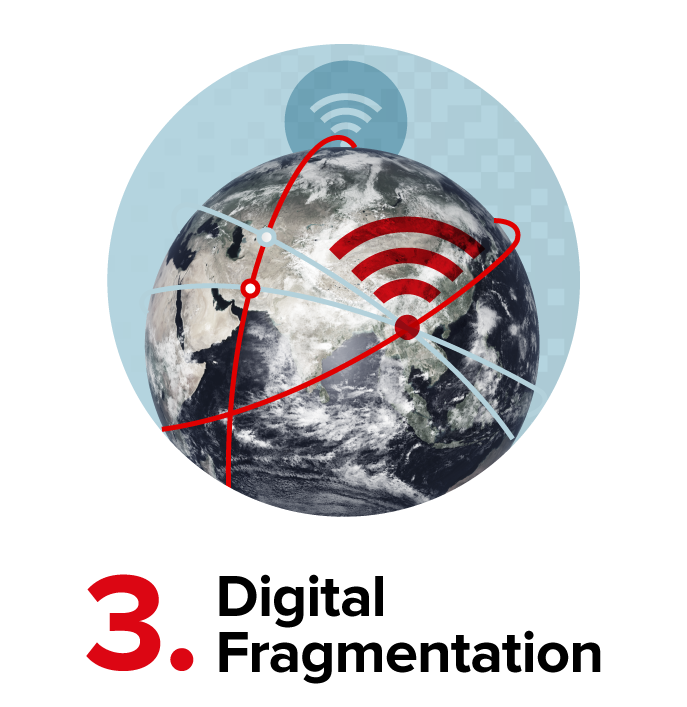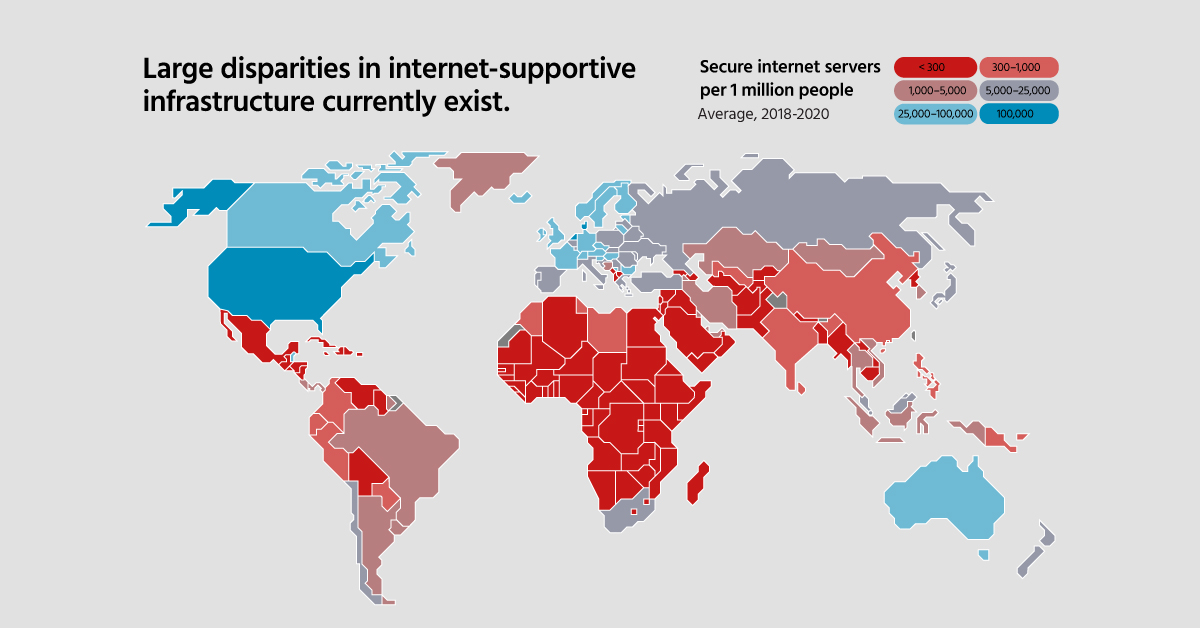Global Trade Series: Fragmentation in the Digital Economy

Global Trade Series: Fragmentation in the Digital Economy
Since its creation, the internet has vastly expanded sociopolitical and economic development around the world. This is largely attributed to the its ability to facilitate communications, data sharing, and commerce on a truly global scale.
Unfortunately, a free and open internet will not always be guaranteed. Fragmentation between rival nations is growing, and it threatens to split the digital economy into silos.
In Part 3 of The Global Trade Series from the Hinrich Foundation, we examine the current state of digital fragmentation and its implications on the world.
The Physical Divide
Developed economies are entering a fourth industrial revolution, spawned entirely by digital technologies. This includes transformative innovations like artificial intelligence, blockchain, and 5G.
These technologies have the potential to improve income levels and quality of life, but they could also worsen global inequality. This is because of a major gap in internet-supportive infrastructure, as illustrated in the infographic.
To get a sense of this gap, consider the following numbers.
- 86 countries have fewer than 300 secure servers per million people
- The U.S. has over 110,000 secure servers per million people
- Denmark, the Netherlands, and Singapore have an even higher ratio than the U.S.
Secure internet servers are the basis of protected communications on the internet. Without them, countries are likely to face difficulty in attracting foreign trade and investment.
Entering Regulatory Overview
Many of the world’s largest economies are making fragmentation worse by erecting barriers between their national digital sectors. Using data from Digital Policy Alert, we can track state interventions by policy area.
Data governance refers to any policies that affect our ability to access or share data. This includes data localization measures, which can hamper digital services from foreign companies. See the table below for the number of policy changes by country, from between January 2018 to September 2022.
| Country | Number of State Interventions (Data Governance) |
|---|---|
| 🇺🇸 U.S. | 283 |
| 🇪🇺 EU | 115 |
| 🇨🇳 China | 73 |
| 🇬🇧 UK | 57 |
| 🇯🇵 Japan | 31 |
| 🌎 Rest of World | 409 |
Another focus area for governments is content moderation, which is any policy that controls online content. The following table lists the number of content moderation policies over the same time period.
| Country | Number of State Interventions (Content Moderation) |
|---|---|
| 🇺🇸 U.S. | 72 |
| 🇷🇺 Russia | 40 |
| 🇪🇺 EU | 38 |
| 🇮🇳 India | 13 |
| 🇨🇳 China | 13 |
| 🌎 Rest of World | 95 |
A recent example of content moderation is China’s campaign to cleanse its local internet of “rumours and false information”. Given the ambiguity of the term “false information”, this initiative could lead to political censorship.
Buying Advantages
In a further display of state intervention, leading economies have been engaged in a decade-long subsidy race to create advantages for their digital sectors.
Subsidies are a form of discrimination in a nation’s trade and investment regulation, and may dissuade potential entrants from participating in its market. Of course, only wealthier governments can play the subsidy game, which is why the majority are attributed to the U.S., China, and the EU.
While American subsidies to the digital sector actually declined during the 2010s, the CHIPS and Science Act of 2022 marks a renewed focus on nurturing domestic industries. More specifically, $280 billion is being allocated over the coming years to “develop onshore domestic manufacturing of semiconductors critical to U.S. competitiveness and national security”.
The New Normal?
At its inception, the internet was intended to be a globally unifying medium. This vision is known as an “open internet” where two parties, regardless of location, are able to exchange data.
Unfortunately, due to state interventions, the internet is now at risk of fragmenting along national jurisdiction lines.
Without a global playbook to guide policymakers, these interventions are likely to intensify digital fragmentation. This denies users choice, stifles innovation, and exacerbates trade tensions.
This infographic was based on a Digital Policy Alert and Global Trade Alert joint report on digital fragmentation, sponsored by the Hinrich Foundation. Download it here now.

-

 Markets5 days ago
Markets5 days agoRanked: The Largest U.S. Corporations by Number of Employees
We visualized the top U.S. companies by employees, revealing the massive scale of retailers like Walmart, Target, and Home Depot.
-

 Economy1 week ago
Economy1 week agoWhere U.S. Inflation Hit the Hardest in March 2024
We visualized product categories that saw the highest % increase in price due to U.S. inflation as of March 2024.
-

 Economy3 weeks ago
Economy3 weeks agoG20 Inflation Rates: Feb 2024 vs COVID Peak
We visualize inflation rates across G20 countries as of Feb 2024, in the context of their COVID-19 pandemic peak.
-

 Economy4 weeks ago
Economy4 weeks agoMapped: Unemployment Claims by State
This visual heatmap of unemployment claims by state highlights New York, California, and Alaska leading the country by a wide margin.
-

 Markets1 month ago
Markets1 month agoConfidence in the Global Economy, by Country
Will the global economy be stronger in 2024 than in 2023?
-

 Maps2 months ago
Maps2 months agoMapped: Breaking Down the $3 Trillion African Economy by Country
The top three economic powerhouses of Africa contribute more than one-third to the African economy. We rank the nations of the world’s second-largest continent by 2024…





